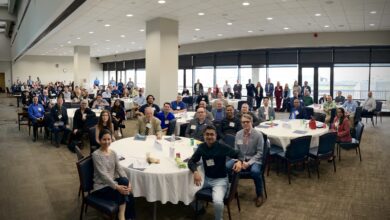
Since I wrote the article “It’s Never Too Late to Get Your PE” for Today’s Engineer back in 2009, my engineering career has reached different dimensions. I obtained my PE license in my home state of Colorado after living in the state for a few months, especially after needing it to begin stamping documents since I began working from home. All I remember about the process was that, once again, I had to get references and college transcripts and tell my engineering story again on a license application. I got my license, but the process made me think long and hard about getting my NCEES record.
Multi-State Licensure and the NCEES Record
What’s an NCESS record? In brief, it is a record of one’s engineering career, references and school transcripts that can be included with a state licensure application. The NCEES record is essential if one is considering multi-state licensure, and even can be of assistance in international licensures and certifications. To start this process, go to the NCEES record page, https://ncees.org/records. Click on “apply now” and begin the application. Once the application is complete, the application fee ($50) is paid and transcripts and references are sent to NCEES, you will have an NCEES record. With a few exceptions, having an NCEES records makes applying to state boards for licensures much simpler. For some states, an accelerated process for approval is used for Model Law applicants.
What is a Model Law applicant? It is a term for someone who has the following:
- Bachelor’s degree in engineering from an EAC/ABET-accredited program
- Four years of acceptable engineering work experience
- Passed the Fundamentals of Engineering (FE) and Principles and Practice of Engineering (PE) exams
- Clean disciplinary record
When the NCEES staff reviews your record, if your application meets the above requirements, you will be designated as a Model Law Engineer. Between the NCEES record and the Model Law Engineer designation, multi-state licensure will be much easier. For me, getting licensed in all 50 states and the District of Columbia became much easier. This process also works for licensure in Guam, Puerto Rico, the Virgin Islands and the Northern Mariana Islands.
Thoughout this process, I have learned that each state and territory does things in its own way. Some licenses are annual, some are bi-annual, and a couple states even have three-year licenses. As one gets different licenses, be aware of the different continuing education requirements, corporate entity issues, and changes in the laws that come with each state.
Canadian Licensure
If your horizons take you beyond the U.S. borders, the NCEES record will assist you in two ways. First, in the same way the NCEES record is sent to individual states, one can also send a record to Canadian provinces. In Canada, licensure is handled at the provincial level in the same way licensure is handled at the state level in the United State. However, the licensing process is a little different. In all the provinces in Canada, the engineering profession is self-regulated. Canada has 12 different engineering associations:
- Association of Professional Engineers and Geoscientists of British Columbia (APEGBC)
- Association of Professional Engineers and Geoscientists of Alberta (APEGA)
- Association of Professional Engineers and Geoscientists of the Province of Manitoba (APEGM)
- Engineers and Geoscientists New Brunswick
- Association of Professional Engineers and Geoscientists of Saskatchewan (APEGS)
- Engineers Nova Scotia
- Engineers PEI (Prince Edward Island)
- Association of Professional Engineers of Yukon (APEY)
- Northwest Territories and Nunavut Association of Professional Engineers and Geoscientists (NAPEG)
- Ordre des ingénieurs du Québec (OIQ)
- Professional Engineers and Geoscientists of Newfoundland and Labrador (PEGNL)
- Professional Engineers Ontario (PEO)
Because of the small number of engineering programs in Canada and the lesser degree of variability in the accreditation process, technical exams like the FE and PE exams are not used in the Canadian Licensure Process. However, a law and ethics examination (Professional Practice Exam) is required to gain Professional Engineering (P Eng) licensure. While each province gives its own version of this exam, each exam is accepted for the most part by all provinces except for Quebec, due to differences in (English) common law and Quebec civil law (based on the Napoleonic code).
International Certifications
The United States is a signatory to the Washington Accord, a treaty which covers international engineering mobility. NCEES Record holders who wish to work abroad can apply to be a part of the International Registry. Once approved, record holders can transmit their record to the following countries (as of April 2015):
- Bureau of Certification for Professional Engineers, Institution of Engineers Indonesia
- Engineers Canada
- Engineering Council of South Africa
- Engineering Council, United Kingdom
- Hong Kong Institution of Engineers
- Professional Regulation Commission, Philippines
- The Board of Engineers, Malaysia
- The Institution of Engineers, Australia
- The Institution of Engineers, Ireland
- The Institution of Professional Engineers, Japan
- The Institution of Professional Engineers, New Zealand
- The Korean Professional Engineers Association
Conclusion
The NCEES Record provides a great way to move forward into multi-state and international engineering practice. Setting up your record is no more difficult than registering for a state license and saves time and hassle when registering in many jurisdictions. Many states provide an expedited process for NCEES record holders applying in their jurisdictions. Like taking the FE and PE exams, the NCEES Record provides flexible options for the future.
David Cotton is Director of RF Compliance at SiteSafe, Inc., a provider of industry-recognized RF health, safety, and regulatory compliance solutions to wireless telecommunications companies. He is a Registered Professional Engineer in all 50 U.S. states, plus the District of Columbia, three Canadian provinces (AB, ON, and SK) and is a Chartered Engineer in the United Kingdom.






